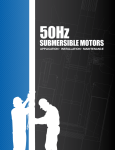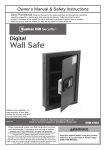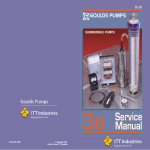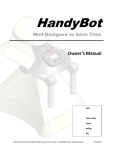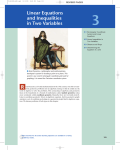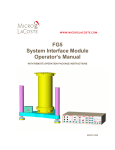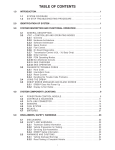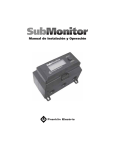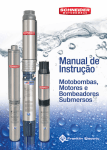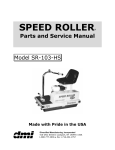Download Three-Phase Motors - Franklin Electric
Transcript
Three-Phase Motors MOTOR APPLICATION Reduced Voltage Starters All Franklin three-phase submersible motors are suitable for full-voltage starting. Under this condition the motor speed goes from zero to full speed within a half second or less. The motor current goes from zero to locked rotor amps, then drops to running amps at full speed. This may dim lights, cause momentary voltage dips to other electrical equipment, and shock power distribution transformers. In some cases the power companies may require reduced-voltage starters to limit this voltage dip. There are also times when reduced-voltage starters may be desirable to reduce motor starting torque thus reducing the stress on shafts, couplings, and discharge piping. Reduced-voltage starters also slow the rapid acceleration of the water on start-up to help control upthrust and water hammer. Reduced-voltage starters may not be required if the maximum recommended cable length is used. With maximum recommended cable length there is a 5% voltage drop in the cable at running amps, resulting in about 20% reduction in starting current and about 36% reduction in starting torque compared to having rated voltage at the motor. This may be enough reduction in starting current so that reduced-voltage starters are not required. Three-Lead Motors: Autotransformer or solid-state reduced-voltage starters may be used for soft-starting standard three-phase motors. Six-Lead Motors: Wye-Delta starters are used with six-lead Wye-Delta motors. All Franklin 6" and 8" three-phase motors are available in six-lead Wye-Delta construction. Consult the factory for details and availability. Part winding starters are not compatible with Franklin Electric submersible motors and should not be used. Wye-Delta starters of the open-transition type, which momentarily interrupt power during the starting cycle, are not recommended. Closed-transition starters have no interruption of power during the start cycle and can be used with satisfactory results. Reduced-voltage starters have adjustable settings for acceleration ramp time, typically preset at 30 seconds. They must be adjusted so the motor is at full voltage within THREE SECONDS MAXIMUM to prevent excessive radial and thrust bearing wear. If Subtrol-Plus or SubMonitor is used the acceleration time must be set to TWO SECONDS MAXIMUM due to the 3 second reaction time of the Subtrol-Plus or SubMonitor. Solid-state starters AKA soft starts may not be compatible with Subtrol-Plus/ SubMonitor. However, in some cases a bypass contactor has been used. Consult the factory for details. During shutdown, Franklin Electric’s recommendation is for the power to be removed, allowing the pump/motor to coast down. Stopping the motor by ramping down the voltage is possible, but should be limited to three (3) seconds maximum. When autotransformer starters are used, the motor should be supplied with at least 55% of rated voltage to ensure adequate starting torque. Most autotransformer starters have 65% and 80% taps. Setting the taps on these starters depends on the percentage of the maximum allowable cable length used in the system. If the cable length is less than 50% of the maximum allowable, either the 65% or the 80% taps may be used. When the cable length is more than 50% of allowable, the 80% tap should be used. Inline Booster Pump Systems Franklin Electric offers three different types of motors for non-vertical applications. 1. 2. The Booster motors are specifically designed for booster applications. They are the “Best Choice” for sealed Reverse Osmosis applications. These motors are the result of two years of focused development and bring additional value and durability to booster module systems. These motors are only available to OEMs or Distributors who have demonstrated capability in Booster Module systems design and operation and adhere to Franklin’s Application Manual requirements. The Hi-Temp motors have many of the internal design features of the Booster motor. It’s additional length allows for higher temperature handling and the Sand Fighter sealing system provides greater abrasion resistance. One or both of these conditions are often experienced in open atmosphere applications such as lakes, ponds, etc. 3. The Standard Vertical Water Well (40-125 hp) motors can be adapted to nonvertical applications when applied per the below guidelines. However, they will be more sensitive to application variances than the other two designs. All of the above motors must be applied per the guidelines listed below. In addition, for all applications where the motor is applied in a sealed system, a Submersible Motor Booster Installation Record (Form 3655) or its equivalent must be completed at start-up and received by Franklin Electric within 60 days. A sealed system is one where the motor and pump intake are mounted in a sleeve and the water feeding the pump intake is not open to the atmosphere. Continued on next page 36 Three-Phase Motors MOTOR APPLICATION Inline Booster Pump Systems (Continued) Design And Operational Requirements 2. Motor, Sleeve, and Pump Support System: The booster sleeve ID must be sized according to the motor cooling and pump NPSHR requirements. The support system must support the motor’s weight, prevent motor rotation, and keep the motor and pump aligned. The support system must also allow for thermal axial expansion of the motor without creating binding forces. 3. Motor Support Points: A minimum of two support points are required on the motor. One in the motor/pump flange connection area and one in the bottom end of the motor area. The motor castings, not the shell area, are recommended as support points. If the support is a full length support and/or has bands in the shell area, they must not restrict heat transfer or deform the shell. 4. Motor Support Material and Design: The support system shall not create any areas of cavitation or other areas of reduced flow less than the minimum rate required by this manual. They should also be designed to minimize turbulence and vibration and provide stable alignment. The support materials and locations must not inhibit the heat transfer away from the motor. 5. Motor and Pump Alignment: The maximum allowable misalignment between the motor, pump, and pump discharge is 0.025 inch per 12 inches of length (2 mm per 1000 mm of length). This must be measured in both directions along the assembly using the motor/pump flange connection as the starting point. The booster sleeve and support system must be rigid enough to maintain this alignment during assembly, shipping, operation, and maintenance. 6. Lubrication and Heat Resistance: The best motor lubrication and heat resistance is obtained with the factory based propylene glycol fill solution. Only when an application MUST HAVE deionized (DI) water should the factory fill solution be replaced. When a deionized water fill is required, the motor must be derated as indicated on the below chart. The exchange of the motor fill solution to DI water must be done by an approved Franklin service shop or representative using a vacuum fill system per Franklin’s Motor Service Manual instruction. The motor shell then must be permanently stamped with a DI closely behind the Serial Number. The maximum pressure that can be applied to the motor internal components during the removal of the factory fill solution is 7 psi (0.5 bar.) 1.8 1.75 1.7 Pump Load Multiplier 1. Non-Vertical Operation: Vertical Shaft-up (0°) to Horizontal (90°) operation is acceptable as long as the pump transmits “down-thrust” to the motor within 3 seconds after start-up and continuously during operation. However, it is best practice to provide a positive slope whenever it is possible, even if it is only a few degrees. Derating Factor for Motors That Must Have Their Factory Fill Replaced With Deionized Water 8" Encapsulated Motor 1.65 1.6 1.55 1.5 1.45 1.4 1.35 1.3 1.25 1.2 1.15 1.1 1.05 1 1.00 Service Factor 1.15 Service Factor 40 35 (50Hz) (60Hz) 30 25 20 15 10 Feed Water Temperature (°C) FIG. 9 First: Determine maximum Feed Water Temperature that will be experienced in this application. If the feed water exceeds the maximum ambient of the motor, both the DI water derating and a hot water application derating must be applied. Second: Determine the Pump Load Multiplier from the appropriate Service Factor curve. (Typical 1.15 Service Factor is for 60 Hz ratings & 1.00 Service Factor for 50 Hz ratings). Third: Multiply the Pump Load Requirement times the pump load multiplier number indicated on the vertical axis to determine the Minimum Motor Nameplate Rating. Fourth: Select a motor with a nameplate equal or higher than the above calculated value. 7. Motor Alterations - Sand Slinger & Check Valve Plug: On 6" and 8" motors, the rubber sand slinger located on the shaft must be removed. If a pipe plug is covering the check valve, it must be removed. The special Booster motor already has these modifications. 8. Frequency of Starts: Fewer than 10 starts per 24-hour period are recommended. Allow at least 20 minutes between shutdown and start-up of the motor. 9. Controls-Soft Starters and VFDs: Reduced voltage starters and variable speed drives (inverter drives) may be used with Franklin three-phase submersible motors to reduce starting current, upthrust, and mechanical stress during start-up. The guidelines for their use with submersible motors are different than with normal air cooled motor applications. Refer to the Franklin Electric Application, Installation, and Maintenance (AIM) manual Reduced Voltage Starters section or Variable Speed Submersible Pump Operation, Inverter Drives sections for specific details including required filtering. Continued on next page 37 Three-Phase Motors MOTOR APPLICATION Inline Booster Pump Systems (Continued) Motor Overload Protection: Submersible motors require properly sized ambient compensated Class 10 quick-trip overloads per Franklin’s AIM manual guidelines to protect the motor. Class 20 or higher overloads are NOT acceptable. Franklin’s SubMonitor is strongly recommended for all large submersibles since it is capable of sensing motor heat without any additional wiring to the motor. Applications using Soft Starters with a SubMonitor require a start-up bypass consult the factory for details. SubMonitor can not be used in applications using a VFD control. 10. Motor Surge Protection: Properly sized, grounded, and dedicated motor surge arrestors must be installed in the supply line of the booster module as close to the motor as possible. This is required on all systems including those using soft-starters and variable speed drives (inverter drives). 11. Wiring: Franklin’s lead assemblies are only sized for submerged operation in water to the motor nameplate maximum ambient temperature and may overheat and cause failure or serious injury if operated in air. Any wiring not submerged must meet applicable national and local wiring codes and Franklin Cable Chart Tables 16-21. (Notice: wire size, wire rating, and insulation temperature rating must be known when determining its suitability to operate in air or conduit. Typically, for a given size and rating, as the insulation temperature rating increases its ability to operate in air or conduit also increases.) 12. 14. Pressure Relief Valves: A pressure relief valve is required and must be selected to ensure that, as the pump approaches shut-off, it never reaches the point that the motor will not have adequate cooling flow past it. 15. System Purge (Can Flooding): An air bleeder valve must be installed on the booster sleeve so that flooding may be accomplished prior to booster start-up. Once flooding is complete, the booster should be started and brought up to operating pressure as quickly as possible to minimize the duration of an upthrust condition. At no time should air be allowed to gather in the booster sleeve because this will prevent proper cooling of the motor and permanently damage it. 16. System Flush – Must Not Spin Pump: Applications may utilize a low flow flushing operation. Flow through the booster sleeve must not spin the pump impellers and the motor shaft. If spinning takes place, the bearing system will be permanently damaged and the motor life shortened. Consult the booster pump manufacturer for maximum flow rate through the pump when the motor is not energized. 17. Open Atmosphere Booster Pump Systems: When an open booster is placed in a lake, tank, etc. that is open to atmospheric pressure, the water level must provide sufficient head pressure to allow the pump to operate above its NPSHR requirement at all times and all seasons. Adequate inlet pressure must be provided prior to booster start-up. Check Valves: Spring-loaded check valves must be used on start-up to minimize motor upthrusting, water hammer, or in multiple booster (parallel) applications to prevent reverse flow. 13. Table 38 Franklin Cable Chart (See item 12 Wiring above) CABLE TEMP. RATING (°C) 75 90 125 #10 AWG #8 AWG #6 AWG #4 AWG #2 AWG MOTOR NAMEPLATE RATED AMPS FULL LOAD IN AIR IN CONDUIT IN AIR IN CONDUIT IN AIR IN CONDUIT IN AIR IN CONDUIT IN AIR IN CONDUIT 3-LEAD (DOL) 6-LEAD (Y-∆) 3-LEAD (DOL) 6-LEAD (Y-∆) 3-LEAD (DOL) 6-LEAD (Y-∆) 40A 69A 44A 76A 66A 114A 28A 48A 32A 55A 46A 80A 56A 97A 64A 111A 77A 133A 40A 69A 44A 76A 53A 91A 76A 132A 84A 145A 109A 188A 52A 90A 60A 104A 75A 130A 100A 173A 112A 194A 153A 265A 68A 118A 76A 132A 105A 181A 136A 236A 152A 263A 195A 337A 92A 159A 104A 180A 134A 232A Based on 30 °C maximum ambient with cable length of 100 feet or less. Continued on next page 38 Three-Phase Motors MOTOR APPLICATION Inline Booster Pump Systems (Continued) Four Continuous Monitoring System Requirements for Sealed Booster Systems. 1. 2. 39 Water Temperature: Feed water on each booster must be continuously monitored and not allowed to exceed the motor nameplate maximum ambient temperature at any time. IF THE INLET TEMPERATURE EXCEEDS THE MOTOR NAMEPLATE MAXIMUM AMBIENT TEMPERATURE, THE SYSTEM MUST SHUTDOWN IMMEDIATELY TO PREVENT PERMANENT MOTOR DAMAGE. If feed water temperatures are expected to be above the allowable temperature, the motor must be derated. See Franklin’s AIM manual Hot Water Applications section for derating guidelines. (The high temperature feed water derating is in addition to the exchange to DI water derating if the motor factory fill solution was exchanged to DI water.) Inlet Pressure: The inlet pressure on each booster module must be continuously monitored. It must always be positive and higher than the NPSHR (Net Positive Suction Head Requirement) of the pump. A minimum of 20 PSIG (1.38 Bar) is required at all times, except for 10 seconds or less when the motor is starting and the system is coming up to pressure. Even during these 10 seconds the pressure must remain positive and be higher than the NPSHR (Net Positive Suction Head Requirement) of the pump. PSIG is the actual value displayed on a pressure gauge in the system piping. PSIG is the pressure above the atmospheric conditions. If at any time these pressure requirements are not being met, the motor must be de-energized immediately to prevent permanent damage to the motor. Once the motor is damaged, it is usually not immediately noticeable, but progresses and results in a premature motor failure weeks or months after the damage occurred. Motors that will be exposed to pressure in excess of 500 psi (34.47 Bar) must undergo special high pressure testing. Consult factory for details and availability. 3. Discharge Flow: The flow rate for each pump must not be allowed to drop below the motor minimum cooling flow requirement. IF THE MOTOR MINIMUM COOLING FLOW REQUIREMENT IS NOT BEING MET FOR MORE THAN 10 SECONDS, THE SYSTEM MUST BE SHUT DOWN IMMEDIATELY TO PREVENT PERMANENT MOTOR DAMAGE. 4. Discharge Pressure: The discharge pressure must be monitored to ensure that a downthrust load toward the motor is present within 3 seconds after start-up and continuously during operation. IF THE MOTOR DISCHARGE PRESSURE IS NOT ADEQUATE TO MEET THIS REQUIREMENT, THE SYSTEM MUST BE SHUT DOWN IMMEDIATELY TO PREVENT PERMANENT MOTOR DAMAGE.




